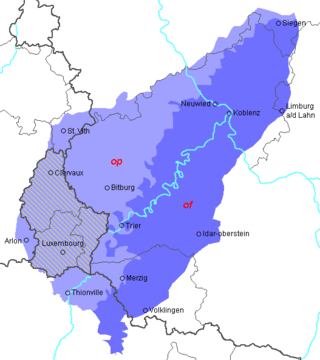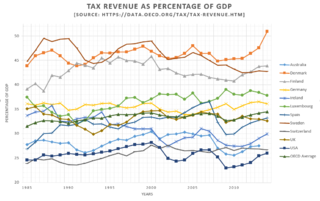
Luxembourg, officially the Grand Duchy of Luxembourg, is a small landlocked country in Western Europe. It borders Belgium to the west and north, Germany to the east, and France to the south. Its capital and most populous city, Luxembourg, is one of the four institutional seats of the European Union and the seat of several EU institutions, notably the Court of Justice of the European Union, the highest judicial authority. Luxembourg's culture, people, and languages are highly intertwined with its French and German neighbors; while Luxembourgish is the only national language of the Luxembourgish people and of the Grand Duchy of Luxembourg, French is the only language for legislation, and all three – Luxembourgish, French and German – are used for administrative matters in the country.

The economy of Luxembourg is largely dependent on the banking, steel, and industrial sectors. Citizens of Luxembourg enjoy the highest per capita gross domestic product in the world, according to an IMF estimate in 2022.

The Luxembourg Armed Forces are the national military force of Luxembourg. The army has been a fully volunteer military since 1967. As of December 2018, it has 939 personnel.

Luxembourgish is a West Germanic language that is spoken mainly in Luxembourg. About 400,000 people speak Luxembourgish worldwide.

Social class in the United States refers to the idea of grouping Americans by some measure of social status, typically by economic status. However, it could also refer to social status and/or location. The idea that American society can be divided into social classes is disputed, and there are many competing class systems.

The middle class refers to a class of people in the middle of a social hierarchy, often defined by occupation, income, education, or social status. The term has historically been associated with modernity, capitalism and political debate. Common definitions for the middle class range from the middle fifth of individuals on a nation's income ladder, to everyone but the poorest and wealthiest 20%. Theories like "Paradox of Interest" use decile groups and wealth distribution data to determine the size and wealth share of the middle class.
An economic migrant is someone who emigrates from one region to another, including crossing international borders, seeking an improved standard of living, because the conditions or job opportunities in the migrant's own region are insufficient. The United Nations uses the term migrant worker.

Forêts was a department of the French First Republic, and later the First French Empire, in present-day Belgium, Luxembourg, and Germany. Its name, meaning 'forests', comes from the Ardennes forests. It was formed on 24 October 1795, after the Austrian Netherlands had been annexed by France on 1 October. Before annexation, the territory was part of the Duchy of Luxembourg and small parts of the Duchy of Bouillon. Its capital was Luxembourg City.

Les Trente Glorieuses was a thirty-year period of economic growth in France between 1945 and 1975, following the end of the Second World War. The name was first used by the French demographer Jean Fourastié, who coined the term in 1979 with the publication of his book Les Trente Glorieuses, ou la révolution invisible de 1946 à 1975. The term is derived from Les Trois Glorieuses, the three days of revolution on 27–29 July 1830 in France.

Luxemburger Wort is a German-language Luxembourgish daily newspaper. There is an English edition named the Luxembourg Times.
Poverty in Switzerland refers to people who are living in relative poverty in Switzerland. In 2018, 7.9% of the population or some 660,000 people in Switzerland were affected by income poverty. Switzerland has also a significant number of working poor, estimated at 145,000 in 2015.

The post–World War II economic expansion, also known as the postwar economic boom or the Golden Age of Capitalism, was a broad period of worldwide economic expansion beginning with the aftermath of World War II and ending with the 1973–1975 recession. The United States, the Soviet Union and Western European and East Asian countries in particular experienced unusually high and sustained growth, together with full employment.
When Luxembourg was invaded and annexed by Nazi Germany in 1940, a national consciousness started to come about. From 1941 onwards, the first resistance groups, such as the Letzeburger Ro'de Lé'w or the PI-Men, were founded. Operating underground, they secretly worked against the German occupation, helping to bring political refugees and those trying to avoid being conscripted into the German forces across the border, and put out patriotic leaflets encouraging the population of Luxembourg to pull through.

In the industrial sector, the Luxembourg steel industry continues to occupy the first place in the country, even after the industrial reforms which have taken place since the 1960s.

Education in Luxembourg is multilingual and consists of fundamental education, secondary education and higher education.
Sweden enjoys a relatively low income inequality and a high standard of living. Unemployment as of 2017 was estimated to be 6.6% by the CIA World Fact Book, lower than in other European Union countries. The Nordic model of a social welfare society exemplified by Sweden and its near neighbours has often been considered a European success story compared internationally with the socioeconomic structures of other developed industrial nations. This model of state provided social welfare includes many unemployment benefits for the poor, and amply funded health, housing and social security provision. within essentially corruption free nations subscribing to principles of a measure of openness of information about government activity. The Income inequality in Sweden ranks low in the Gini coefficient, being 25.2 as of 2015 which is one of the lowest in the world, and ranking similarly to the other Nordic countries; although inequality has recently been on the rise and several central European countries now have a lower Gini coefficient than Sweden.
Emile Haag is a Luxembourgish historian, trade unionist and former principal of the Athénée de Luxembourg. Since 1987 he has been the national president of the confederation of government employees, a Luxembourgish trade union. In 1997, he was made commander of the Ordre de la couronne de chêne. Between 2005 and 2015 he was also President of the chamber for government employees. On 29. Juni 2015 he was made honorary president of that chamber.
The "Projet PIBien-être" is the first official initiative for measuring well-being and quality of life in Luxembourg.

Tax revenue in Luxembourg was 38.65% of GDP in 2017, which is just above the average OECD in 2017.
The Colombian middle class is a social class in Colombia, it is a broadly used term. There are many definitions. Middle class also has subcategories, such as upper middle class and lower middle and it can contain a very large number of individuals with vastly different professions and ways of living. Middle class and the overall standards of living are affected by the economy of a country, one which has a growing economy and positive economic indicators, will be more likely to have a larger middle class with decent standards of living and less inequality. Colombia is a country that has been experiencing a significantly fast economic growth, which has impacted the income, wealth and expenditure of its population, and the proportion of its population belonging to middle class.

















